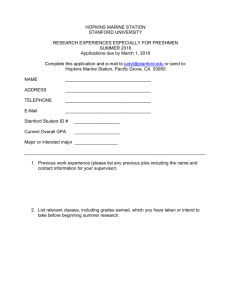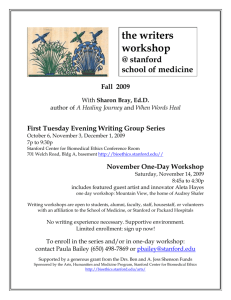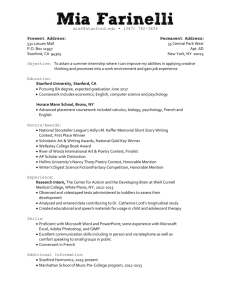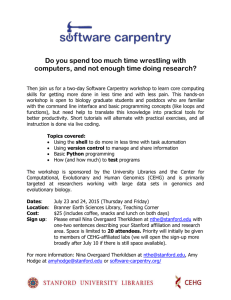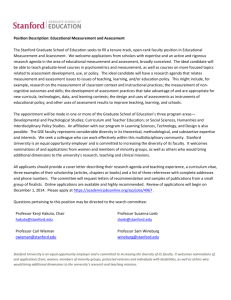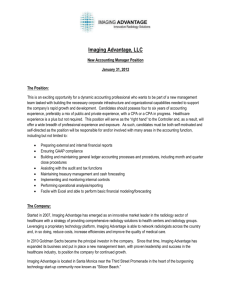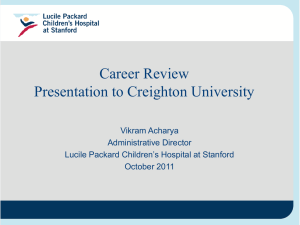DeanNews04-13-09 - The Dean`s Newsletter
advertisement
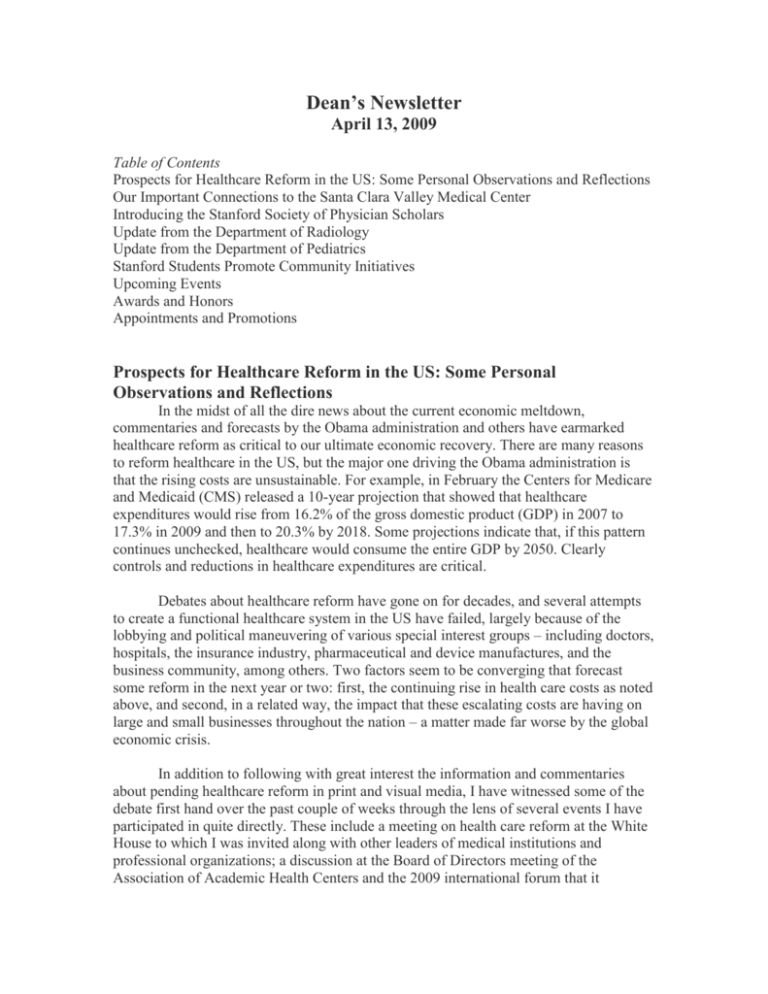
Dean’s Newsletter April 13, 2009 Table of Contents Prospects for Healthcare Reform in the US: Some Personal Observations and Reflections Our Important Connections to the Santa Clara Valley Medical Center Introducing the Stanford Society of Physician Scholars Update from the Department of Radiology Update from the Department of Pediatrics Stanford Students Promote Community Initiatives Upcoming Events Awards and Honors Appointments and Promotions Prospects for Healthcare Reform in the US: Some Personal Observations and Reflections In the midst of all the dire news about the current economic meltdown, commentaries and forecasts by the Obama administration and others have earmarked healthcare reform as critical to our ultimate economic recovery. There are many reasons to reform healthcare in the US, but the major one driving the Obama administration is that the rising costs are unsustainable. For example, in February the Centers for Medicare and Medicaid (CMS) released a 10-year projection that showed that healthcare expenditures would rise from 16.2% of the gross domestic product (GDP) in 2007 to 17.3% in 2009 and then to 20.3% by 2018. Some projections indicate that, if this pattern continues unchecked, healthcare would consume the entire GDP by 2050. Clearly controls and reductions in healthcare expenditures are critical. Debates about healthcare reform have gone on for decades, and several attempts to create a functional healthcare system in the US have failed, largely because of the lobbying and political maneuvering of various special interest groups – including doctors, hospitals, the insurance industry, pharmaceutical and device manufactures, and the business community, among others. Two factors seem to be converging that forecast some reform in the next year or two: first, the continuing rise in health care costs as noted above, and second, in a related way, the impact that these escalating costs are having on large and small businesses throughout the nation – a matter made far worse by the global economic crisis. In addition to following with great interest the information and commentaries about pending healthcare reform in print and visual media, I have witnessed some of the debate first hand over the past couple of weeks through the lens of several events I have participated in quite directly. These include a meeting on health care reform at the White House to which I was invited along with other leaders of medical institutions and professional organizations; a discussion at the Board of Directors meeting of the Association of Academic Health Centers and the 2009 international forum that it sponsored; a special retreat of the Council of Deans that focused on the changes that will likely ensue with significant healthcare reform as well as the current economic crisis; and a dialogue at the Council of the Institute of Medicine. Distilling and synthesizing some of the viewpoints, observations and facts discussed and presented at these events and at others during the past weeks lead to several general deductions – which I readily admit I will convey through my own personal lens. While each point can be discussed and debated in detail, I thought it reasonable to share just some high level assessments – since I think they best set the stage for some of the changes that may occur over the next months to years. It is important to begin with a qualifier. While many experts and pundits believe this is the moment in history for significant healthcare reform, it must be underscored that we have come up to the edge of reform in the past and backed away. Of course the current economic forecasts and chaos as well as what seems to be a greater willingness of the major and often opposing constituencies to at least come to the table seem to be harbingers for reform. But whether this will be marginal, incremental or transformative remains to be seen. At least as expressed at the White House meeting I participated in, the three driving areas of focus are cost containment, enhancing quality and improving access. Of course these are interrelated and intersecting. However, I would say that cost containment is the overarching and driving mandate. Controlling costs and reducing healthcare expenditures cannot be accomplished without major shifts in the provider-payer community, and these will affect every sector of the healthcare environment. The degree of impact will be influenced of course by the rate of change and the areas of primary focus. But it seems unassailable that every service, profession, and industry will be affected in some way – some more significantly than others. That said, it must be quite clear to everyone that significant change will not occur easily. Each sector and industry will have its own debates. Take the medical profession as an example. In principle everyone wants reform. But if cost containment means changes in physician compensation (which seems inevitable), there will be fierce debates about whose compensation goes up or down, since the total amount of healthcare dollars available for physician payment will almost surely decline. This was evidenced at the White House meeting I referred to above, at which specialty groups acknowledged that payments for primary care doctors were low and should increase – but not at the expense of payments for specialists. Clearly this math won’t work. Several professional organizations have forecast a significant shortage in the physician workforce in the next decades, made worse by the aging of the population. This has led the AAMC to promote a 30% increase in the size of medical school classes in order to produce more doctors for the 21st Century. While there will surely be shortages in selected areas and disciplines, it is not clear to me that increasing medical school class size will change this projected shortages. Most notable is the relative shortage of primary care physicians, of which the US has a lower proportion than any other developed nation. In fact, as I have written about frequently, this trend is increasing over time for a complex variety of intersecting events. Among these are the choices of medical school graduates, who more than ever are seeking careers that balance work and family. This has led many graduates, including the very best students, at least academically, to choose career paths like dermatology, radiology, anesthesia, and surgical subspecialties rather than primary care. This trend is made worse by the cultural perception around primary care as the “lost leader” that does not command the respect or remuneration of other specialties. In fact, the lower compensation for primary care and cognitive specialties is a significant factor influencing medical school graduates – as well as the career satisfaction of physicians in practice. These choices are also influenced by the rising costs of medical school indebtedness (now over $180,000 for private medical schools, although Stanford continues to have the lowest amount of indebtedness of either public or private medical schools), which affects the decision of whether to pursue a lower paying primary care career or a higher paying specialty pathway. Given that the choice of primary versus specialty care is influenced by multiple factors and that there are approximately twice the number of ACGME approved residency positions as there are graduates of the 130 allopathic medical schools, it is likely that simply increasing the number of medical school graduates will not necessarily change the career choice or the ultimate geographic workplace of medical school graduates. Simply put, just increasing medical school class size will not solve the primary care workforce. While some are talking about doing this by altering the distribution of CMS funded residency slots between primary and specialty care, it is unlikely that this will be successful unless compensation for primary care physicians is addressed. Further, it is not clear that doctors are the only or even the correct solution to the primary care challenge we face today. From my perspective, the primary care needs of the nation can only be solved if doctors join forces with other health professionals – especially with nurses who have advanced degrees (including nurse practitioners and the newly created Doctor of Nursing Practice). This will mean more cooperation among physician and nursing professionals (and their schools and organizations) as well as more team based education and practice. Health care providers will be increasingly judged and paid on quality metrics, a process already underway. This will include payments to doctors as well as hospitals. Increasingly, evaluations of physician performance will be made more publicly available, including on the web. Solving the access problem (especially for the 40 million American uninsured or underinsured) will require a number of changes. These include changes in public and private providers and almost certainly a requirement/mandate that everyone must have healthcare coverage. For those who can’t afford private insurance, a public system (analogous to Medicare) has been proposed. This is one of the more controversial and politically challenging areas for discussion. Because a large public payer will have the power to negotiate for lower prices and to offer coverage at a lower cost, it would seem inevitable that many individuals will migrate from private to public insurance. This has many concerned that the insurance industry as we know it today will become marginalized and the public system will grow – as is the case in most other nations. Presently, Medicare (or public funding) accounts for about 50% of health care coverage. If a public system allowed this to increase to 75% or more over time, it would radically reshape the health care environment – moving it from an employer based model to a single payer system. I have previously registered my own support for a single payer system, even though I know it would pose a number of challenges to academic medical systems. In a small way, this was part of the debate around SCHIP during the Bush administration – and SCHIP has now been passed by the Obama administration. It is clear that, however it is accomplished, dealing with access is a key component of reform – but achieving this in a way that both sustains quality and achieves cost containment is also critical. Cost containment will focus attention on the perverse incentives that drive US medicine and healthcare. The fact that doctors and hospitals are paid more for procedures and technologies does just what you’d expect. It increases the use of technology, not a small amount of which is unproven, as well as high-end procedures and surgeries. There is ample data demonstrating that more medical care, including spending more on healthcare, is not associated with improved outcomes. In fact, in certain sectors there is an inverse relationship. But because market forces have driven medicine and healthcare, doctors, hospitals and health care systems have focused both on those services that provide higher reimbursements and on the payer mix of patients – which not infrequently means increasing the proportion of selected private insurance payers. The actual mix varies among and within states, but the guiding strategies are the same. They account for why community hospitals become competitive with larger tertiary facilities and may even include patient selection as part of the strategy. In many ways the current payment schedules have created the incentives that now drive healthcare costs. They need to be changed, but doing so will be accompanied by significant opposition and challenge. Part of the perverse incentives includes the cost of drugs, devices and technologies. There is no doubt that major advances in healthcare outcome are the result of new drugs, innovative medical devices and sophisticated technology, especially in imaging. But many of these new innovations are unproven and costly and are applied with as much of an eye toward profit as toward outcome. While we would like to think that clinical trials and the peer reviewed medical literature set a standard of excellence, it is quite clear that in many cases they do not. Even worse, in some egregious instances doctors and industry have promoted advances in care or diagnosis for personal or institutional profit. Even when bias has been unintended, the need for profit by industry as well as hospitals and doctors has resulted in some unfortunate examples of personal and institutional conflict of interest. A likely key part of the solution to controlling medical costs for new technologies and drugs will be a health oversight board – something also being discussed by the Obama administration. In the absence of regulation, market forces and persuasion rather than data influence the introduction of new procedures, drugs, and devices. Significant improvements in the assessment of health outcomes and the benefits from a whole variety of interventions are viewed as another way of controlling costs. But it must be also acknowledged that gathering reliable health outcome and cost data is not as easy as it may sound. But such data are very much part of the potential remedy for health care. Another major remedy being discussed is the electronic healthcare record. It is amazing to note the low number of physicians and hospitals now using an EMR, and there is no doubt that a functional EMR will improve data access, quality monitoring and outcome, reduce errors, and improve portability of healthcare information. It also carries a number of risks regarding patient confidentiality and security and, we all recognize, it is expensive. There is a debate about whether an EMR will actually reduce healthcare costs as some in the Obama administration have forecast. But there can be no question that it is an essential part of a more functional healthcare system. I have been told by some of my colleagues that the EMR being used in the United Kingdom is highly effective – but it is important to note that this has been built on a reasonably functional (certainly as compared to the US) healthcare delivery system – which is what we do not have. In any event, significant dollars are being expended in the American Recovery and Reinvestment Act (ARRA) to foster development of an EMR, so it is likely that progress will be made in this domain. Unlike other nations, there are few if any constraints on healthcare tests and procedures for those with insurance. The debate about whether we can afford to spend so much of the health care dollar during the last 6-12 months of life will be an important one – with individual and societal ethical issues to be resolved. Indeed, discussion about the levels and extent of care provided at both ends of the life cycle seem inevitable, although I suspect that these will not be part of the initial dialogue about healthcare reform in the next couple of years. That said, this is an area where new technology may have a beneficial effect in moving the locus of care from institutions to home – and this could be an important area of focus for Stanford, given the close partnership that the Medical School has with the School of Engineering. Appropriately, the Obama administration has placed increased focus on health, wellness and prevention as remedies for controlling costs as well as for improving the quality of life. This is an important issue and it deserves attention. There are clear data showing that exercise can reduce morbidity and mortality from cardiovascular disease. And there is clear evidence that obesity in children, adolescents and adults, which is increasingly prevalent, increases the risk for a number of chronic medical conditions and so needs to be addressed. These and a plethora of other wellness strategies deserve attention, as we have been a nation and system more focused on disease management than health maintenance. That said, the data demonstrating that preventive health will have a major impact on healthcare costs are unclear at this point. But wellness is worth our focus independent of costs. Each of the meetings I referred to and virtually every other discussion on healthcare I have participated in has also identified the need to better address the management of individuals with chronic disorders. The market-based health care system we have today does not align to the care of this important patient population. Because they take more time and resources, they are frequently triaged or avoided by many health care providers, which ultimately results in poorer care and greater costs. Except for research on health outcomes and cost, almost all of the discussions about healthcare reform are silent on the subject of biomedical research. Not surprisingly, the discussion at the Council of Deans last week made this connection quite clear and underscored the importance of basic and clinical research in improving future healthcare outcomes and in effecting cost containment. This is two-edged, since new discoveries can also increase costs if they are implemented and paid for before there is evidence that they are real advances in the healthcare armamentarium. But there can be no doubt that research in the basic biosciences and in clinical and translational science is a fundamental underpinning of a future healthcare system. These are some of the observations, recommendations and issues that seem to be unfolding in the current healthcare reform debate. While it is difficult to determine which of these will emerge as leaders of the change process, it seems clear that the focus will be around cost containment. The obvious implication for all of healthcare, including academic medical centers like Stanford, is that the clinical revenue to physicians and hospitals will decline in the years ahead – at least proportional to the patterns that have been witnessed in the past decade. While these changes have been increasingly inevitable, they have been dramatically increased by the economic meltdown of the last year. This has made the call for change, and the likelihood that it will take place in the next couple of years, more likely than ever before. Obviously our challenge is to do what we can to participate in the debate and discussion on healthcare reform as well as to prepare for its consequences. Sustaining flexibility, avoiding fixed overhead expenses, seeking the right balance of our missions, including the size and focus of our faculty and staff, will be critically important. That we have been engaged in proactive planning over the past years is a benefit –but we need to recognize that our prior planning will almost certainly require adjustment and accommodation as things unfold in the immediate future. At the same time, we also need to do all we can to communicate what we bring to the nation’s healthcare mission. Academic medical centers constitute only 2% of the healthcare providers, but they participate in the care of a significant percentage of the nation’s sickest patients. They also train tomorrow’s doctors and leaders as well as create the knowledge that can transform health outcomes. But in recent years we have lost some of the public trust as academic medical centers have been caught up in allegations of financial avarice and in assertions that we have been inattentive to the real needs of the communities we serve. Clearly these issues also need to be addressed if we are to be players and future participants in healthcare reform and the future of medicine and science in the US. Our Important Connections to the Santa Clara Valley Medical Center The affiliation of Stanford and the Santa Clara Valley Medical Center (SCVMC) has a long and rich history grounded in a shared commitment to education (at both the undergraduate and graduate levels), patient care and research. SCVMC is presently a 574 bed facility with new and extensive ambulatory facilities whose history dates back to the latter part of the 19th century and whose affiliation with the Stanford School of Medicine began in 1959 – the year the medical school relocated to the Stanford campus. Since then it has developed important relationships with multiple residency programs at Stanford and has been an important and highly regarded site for medical student education Over the years I have been at Stanford, Dr. Norm Rizk, the Berthold and Belle N. Guggenhime Professor of Medicine and Senior Associate Dean for Clinical Affairs, and I have met at regular intervals with Dr. Alfonso Banuelos, Chief Medical Officer at SCVMC, and Dr. Dolly Goel, Medical Director there, to review shared programmatic initiatives in education, clinical programs and community initiatives. On Thursday April 2nd, thanks to an invitation from Dr. Clifford Wang, President of the SCVMC Medical Staff, Dr. Rizk and I had the opportunity to attend their medical staff meeting.. In addition to their reports, Ms. Kim Roberts, CEO, gave an update on the federal, state and community issues impacting SVCMC. While there are differences between the issues that Stanford is facing and those at SCVMC, there are some commonalities as well. Accordingly, I gave an overview of the impact of the current economic downturn on our missions in education, research and patient care, and I also discussed how we are addressing these issues in our efforts to stay focused on our overarching goals and strategic initiatives. I am always impressed by the dedication of the physicians and faculty who work at SCVMC to the patients and community they serve. While the term “county hospital” can evoke many visual connotations, SCVMC is distinctive in having outstanding patient care facilities, including a new state-of-the-art ambulatory care center that opened in February and that we had the pleasure of touring. In addition, the SCVMC will soon break ground on a new in-patient bed tower that constitutes the next phase of their master facilities program. The impressive physical facilities convey to patients and their families that their community values them – which is precisely the right message, especially during these economically challenging times. Importantly, the excellence of these facilities is well matched by the commitment of the medical staff to patient care and to the very important and valued role they play in the education of our students and trainees. For this we must all be grateful and appreciative. Introducing the Stanford Society of Physician Scholars Virtually everyone who has gone through medical school and postgraduate education recognizes the lack of continuity and, in some cases, almost disconnectedness between clinical medicine and basic science – and between undergraduate and postgraduate medical education. We have made considerable efforts to address the connections between science and medicine in our New Stanford Curriculum, which commenced in the Fall of 2003 (see: http://med.stanford.edu/md/). Students begin learning the basic science and science of medicine from the start of medical school, and they continue that integrated learning throughout their undergraduate medical education. In the most simplistic manner, this fosters an understanding of the scientific underpinnings of clinical medicine – a goal espoused by Abraham Flexner when he issued his report on medical education nearly a century ago. We have also gone a step further with Stanford medical students by requiring that they each pursue a “scholarly concentration” that focuses them on scholarship and research and helps prepare them for lifetime learning. But our efforts at integrating science and medicine are often lost with the start of residency and postgraduate education. The demands of patient care often leave little time to draw connections back to basic science. And most clinical faculty focus their teaching and interactions on patient management rather than discussions about the basis for disease at a fundamental level. Indeed, the pressures and demands on clinical faculty limit even their own ability to keep abreast of the scientific developments in their fields. While this might be a focus of “continuing medical education,” it too has been largely relegated to disease management and diagnostics and not to scientific integration. As knowledge expands in science, and the demands of medical practice increase, the prospect that clinicians and scientists will draw even further apart in their shared learning is a real concern. At its extreme this could relegate clinical medicine to a “trade” rather than a science-based profession. Indeed the curtailed focus on basic science to shorten the time of training that has been proposed for some new medicals schools could inadvertently widen this information divide. For some years I have commented on the importance of drawing our programs and opportunities in undergraduate and medical education more closely together. And while we have made some progress, we have only barely achieved the kind of integration that would create new linkages for residents and fellows with medical and graduate students and the School of Medicine. On Friday, April 3rd, Dr. Charles Prober, Professor of Pediatrics and Senior Associate Dean for Medical Education, gave an update on a new program that can help foster better connections. It is modeled very loosely on a program at UCSF that Dr. Steve Galli, the Mary Hewitt Loveless Professor and Chair of the Department of Pathology, called to our attention. Building on that, Dr. Prober and his colleagues propose establishing the Stanford Society of Physician Scholars (SSPS), which would connect residents to medical school faculty, students and programs. In this program, residents selected by their home department would participate in a seminar series that would provide guidance on career development, leadership and mentoring, research and funding strategies. The SSPS would provide mentors for the resident as well as an expectation that residents would in turn provide mentorship for medical students. Drawing residents and students more closely together around scholarship, learning and teaching could foster important new synergies and opportunities. These could be connected to any of our Scholarly Concentrations (see http://med.stanford.edu/md/curriculum/scholarly_concentrations/) and thus create new alignments of undergraduate students and postgraduate trainees around areas of shared interest and opportunity. Importantly, it would also bring residents from different disciplines into a common forum and thus permit more interdisciplinary education and knowledge sharing. The Stanford Society of Physician Scholars is still a concept but there is every intent to launch it this year and to further the process of better integrating our education programs across the continuum and hopefully, of improving the opportunities of postgraduate trainees to continue to link medicine and science. Update from the Department of Radiology On Friday, March 20th, Dr. Gary Glazer, the Emma Pfeiffer Merner Professor and Chair of the Department of Radiology gave an update on the department of Radiology to the Executive Committee. Over the past two decades Dr. Glazer and his colleagues have built what is unquestionably one of the most notable academic departments of radiology in the world. He provided the following summary of his presentation. The Department of Radiology has created new clinical and research initiatives in medical imaging by investing heavily in people and resources to help solve major problems in health care and science. Deeply committed to patient care, Radiology faculty and staff provide service to Stanford University Hospital (SUH); Lucile Packard Children’s Hospital (LPCH); the Palo Alto VA Hospital; and two new outpatient imaging centers: Stanford Medicine Imaging Center (SMIC or “Sherman”), Palo Alto, and Stanford Medicine Outpatient Center (SMOC), Redwood City. As subspecialty experts, Stanford radiologists are very clinically active, performing nearly 1,000 examinations each day. Consequently, Radiology was the third largest producer of wRVUs in the School of Medicine (SOM) for fiscal year 2008. Dedicated to the growth of the SOM and the University, Radiology’s combined revenues have grown by more than 580% since 1990 and over 50% since 2005. Radiology also provides very substantial revenues to our Hospitals through the technical fees for imaging. In addition to its subspecialty clinical divisions, Stanford Radiology is divided into three major research sections: the Radiological Sciences Laboratory (RSL) headed by Gary Glover; the Molecular Imaging Program at Stanford (MIPS) headed by Sam Gambhir; and a new section called ISIS (Information Sciences in Imaging @ Stanford) co-directed by Sandy Napel and Sylvia Plevritis. Each of these sections is devoted to both basic and applied research. Norbert Pelc serves as the Associate Chair for Research and was a founding member of the RSL. The Department has built bridges between the clinicians and scientists of Radiology as well as with other departments at Stanford. Today we collaborate with over 30 departments within the University. These collaborations have resulted in major advances, which have been rapidly translated into clinical medicine. Stanford is recognized internationally as a major epicenter for innovation in magnetic resonance imaging, fMRI, CT scanning, 3D image visualization, and in vivo cellular and molecular imaging. We are very pleased to house 3 major NIH funded Centers of Excellence: the National Center for Advanced Magnetic Resonance Technology; the In Vivo Cellular and Molecular Imaging Center at Stanford; and the Center for Cancer Nanotechnology and Excellence Focused on Therapy Response. Radiology’s research success is reflected in exceptionally strong NIH funding and its unique imaging infrastructure, which attracts trainees worldwide who come to study the latest imaging techniques at the Department’s Richard M. Lucas Center for Imaging. As a result, the Department’s educational programs have continued to expand, and the number of graduate students, postdoctoral scholars, residents, and clinical fellows has increased to over 150 in 2009. Similarly, the Continuing Medical Education (CME) Program has grown to include more than 3,600 learners a year from 25 countries. Over the past few decades the Department has built strong partnerships with industry resulting in an imaging infrastructure that is world-class. For example, the multimodality small animal imaging lab, our high field MR equipment, the cyclotron and radiochemistry facility, and our leading edge CT scanners provide outstanding imaging resources to the Stanford community. We look forward in the years ahead to bringing breakthroughs in imaging and molecular medicine together to advance science and help in the earlier detection of disease and its personalized therapy. Update from the Department of Pediatrics Dr. Hugh O’Brodovich, the Arline and Pete Harman Professor of Pediatrics, became Chair of the department of Pediatrics on January 3rd, 2008. He presented an update of the department’s demographics, vital statistics and strategic directions to the Executive Committee on Friday April 3rd. At the opening of his presentation he credited the significant growth in the department over the past decade to its past leadership and to the $500 Million Childrens’ Health Initiative (CHI). The CHI resulted from philanthropic donations from the David and Lucile Packard Foundation, Lucile Packard Foundation for Children’s Health and the community. He provided the following brief summary of his comments. The Department currently has 222 members. The changing demographics of the Department can be illustrated by several examples. First, the majority of the members are Clinician Educators (112), who are concentrated in the Divisions of General Pediatrics and Neonatology. The other members of the Department are 24 University Tenure Line, 57 Medical Center Line, 7 Non-tenure Line (Research), 2 Non-tenure Line (Teaching) and 20 Instructors. Second, the faculty, overall, has 27% minority and 37% female members. However, the majority of Assistant Professors (60%) are female. The increase in the female:male gender ratio is beginning to be reflected in the leadership of the department: two of the three recently appointed division chiefs and the majority of both the Pediatric Executive and Departmental Advisory Committees are women. The CHI enabled the recruitment of a significant number of new faculty. This, in part, is responsible for the improvement in sponsored research projects, in which combined direct and indirect expenditures have risen from ~$8 million in fiscal 1998 to $27 million in fiscal 2008. The department actively participates in undergraduate education; for example, 7 of our faculty members are directors/co-directors of scholarly concentration programs. The pediatric residency program has been recently expanded to 26 residents in each of the three years, and they carry out their training at the LPCH, Santa Clara Valley Medical Center, Kaiser and the community. Efforts are underway to expand the number of fellows from the current inadequate number (55) of fellows in the 14 pediatric subspecialties. During the fall of 2007, prior to Dr. O'Brodovich’s arrival, he completed a Strategic Planning process over 4 months in which the advice of department members was obtained through a consultative process carried out by department member teams assigned to each of the research, education, clinical care and administrative areas. The approach used a SWOT analysis and resulted in 6 Strategic Goals that the department is currently actively pursuing. Stanford Students Promote Community and Public Service Initiatives I was very pleased to participate, if only at the margin, in an undergraduate initiative entitled Vision Stanford 2020, which brought students, faculty and staff from across the university to share knowledge and experience about the community initiatives now taking place at Stanford and, more importantly, to probe the question of how to make community and public service a more seamless part of academic life. What was particularly gratifying, and even inspirational, was to witness the deep commitment of students from various disciplines and schools (including the medical school) to reaching out to serve our communities locally and globally in meaningful ways. This was not altruism per se (although some of that is not bad) but a serious effort to assure that public service is valued along with research and scholarship in the Stanford community. Given the inordinate focus in recent years on material gain and a mindset too often “me and not we” it was reassuring and impressive to witness the clear-minded and non-maudlin value placed on public service. Despite all the downturns we face today, this was a distinctly uplifting message, even with all of its challenges. Thankfully, it is notable how many community-based activities are already underway across campus. In addition to those at the Haas Center for Public Service, virtually every Stanford school sponsors student organizations and community offices and activities. Making these activities better known and more appropriately valued will be a big step forward – and one that the students and Vision Stanford 2020 are intent on doing. I certainly wish them every success in achieving their vision and goals. Upcoming Events: East-West Alliance Conference on Longevity The East-West Alliance is a global network of ten institutions, including the Stanford University School of Medicine, that have been supported by the Li Ka Shing Foundation. The Alliance convenes annually at one of its member institutions to address significant scientific issues at a public conference. The School of Medicine is this year’s host. The focus for the 2009 conference is longevity across the life span. The Alliance, the Stanford Center on Longevity and the School of Medicine have brought together leading experts across a broad range of disciplines to address longevity-related topics in their fields. Session themes will include genetic considerations of longevity, stem cell connections to longevity, social correlates of longevity, longevity implications for the medical workforce, and economic correlates of longevity. Dr. Laura Carstensen, Professor of Psychology and Fairleigh S. Dickinson Jr. Professor in Public Policy, will give a plenary address on “Longevity in the 21st Century.” Session moderators will include Stanford faculty members Dr. Stuart Kim, Professor of Developmental Biology and of Genetics and, by courtesy, of Chemical and Systems Biology; Dr. Tom Rando, Professor of Neurology and Neurological Sciences and Deputy Director, Stanford Center on Longevity; Dr. Paul Wise, Richard E. Behrman Professor in Child Health and Professor, by courtesy, of Health Research and Policy; Dr. Ralph Horwitz, The Arthur L Bloomfield Professor of Medicine and Chair of the Department of Medicine; and Dr. John Shoven, The Wallace R. Hawley Director, SIEPR, Charles Schwab Professor of Economics and Senior Fellow, by courtesy, at the Hoover Institution Date and Time: Wednesday, April 15, 2009, 1:30 p.m. – 4:30 p.m. Thursday, April 16, 2009, 8:30 a.m. – 12:00 p.m.; 1:15 p.m. – 5:00 p.m. Location: Clark Center Auditorium Admission: Free. Open to the public For more information: contact Mira Engel at mengel@stanford.edu Medicine and the Muse Dr. Audrey Shafer asked me to remind you about a terrific upcoming event, “Medicine and the Muse: An Arts, Humanities and Medicine Symposium,” which will be held on Tuesday, April 28, 2009 at 5 pm in the Clark Center Auditorium. This year’s event will feature Rob Kapilow (http://www.robkapilow.com) and the St. Lawrence String Quartet (http://slsq.com/home/index.html) – both of whom are truly wonderful. In addition, there will be music, presentations and art contributions by Stanford Medical Students. A reception and exhibit will follow in the Nexus Café in the Clark Center at 7 pm. The Biomedical Ethics and Medical Humanities Scholarly Concentration; Arts, Humanities and Medicine Program; and the Stanford Center for Biomedical Ethics sponsor this terrific event. (http://bioethics.stanford.edu/arts/). Medical Student Research Symposium On Thursday, May 7th, the 26th Annual Medical Student Research Symposium will be held in Hospital Atrium from 3:00-6:00pm. Close to 30 MD and MD/PhD students will present their original research presentations. Students will be available at their posters for informal discussion from 3:00-5:30pm. At 5:45 pm following closing remarks the event will culminate with the announcement of student awards by the Stanford Medical Alumni Association. Two student presentations from the Symposium on May 7th will be invited to give an oral presentation at Medicine Grand Rounds on Wednesday, June 3rd at 8:00am in Braun Auditorium in the Mudd Chemistry Building. This promises to be a terrific event and we hope you will join our students for this year's Student Research and Population Health Symposium. Awards and Honors Dr. Paul Auerbach, Professor of Surgery (Emergency Medicine) has been awarded the 2009 DAN/Rolex Diver of the Year Award. This award is given each year to an individual who has contributed significantly to dive safety or the DAN mission. Dr. Auerbach has written extensively on topics promoting dive safety, and has assisted with the development of the DN First Aid for Hazardous Marine Life training program. Congratulations, Dr. Auerbach! Dr. Stanley Rockson, the Allan and Tina Professor of Lymphatic Research, has been selected to be the inaugural recipient of the Pioneer Award from the Lymphatic Research Foundation (LRF). This award is presented to an individual who has been, and is, dedicated to the mission of the LRF. Congratulations, Dr. Rockson! Dr. Irv Weissman, Virginia & D.K. Ludwig Professor for Clinical Investigation in Cancer Research, Professor of Developmental Biology &, by courtesy, of Biology, has been selected to receive the 2009 Passano Award. This award recognizes the originality and important of Dr. Weissman’s work, and his groundbreaking contributions in the field of modern stem cell biology. Congratulations, Dr. Weissman! Appointments and Promotions Todd Alamin has been promoted to Associate Professor of Orthopaedic Surgery at the Stanford University Medical Center, effective 4/01/09. Jaime Lopez has been reappointed to Associate Professor of Neurology & Neurological Sciences and, by courtesy, of Neurosurgery, at the Stanford University Medical Center, effective 4/01/09. Anna H. Messner has been promoted to Professor of Otolaryngology – Head and Neck Surgery and of Pediatrics at the Stanford University Medical Center, effective 4/01/09. Terry E. Robinson has been promoted to Associate Professor of Pediatrics at the Lucile Salter Packard Children’s Hospital, effective 4/01/09. Theresa A. Tacy has been appointed to Associate Professor of Pediatrics at the Lucile Salter Packard Children’s Hospital, effective 4/01/09.
